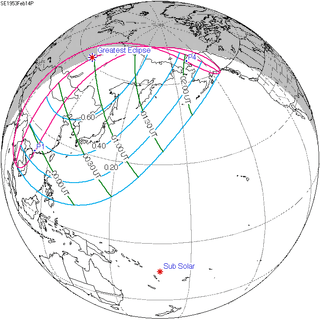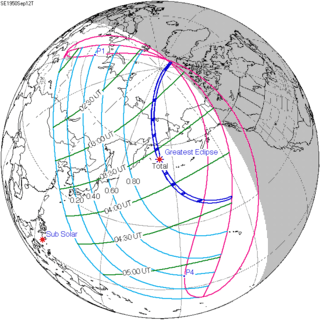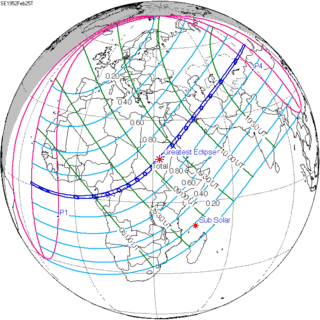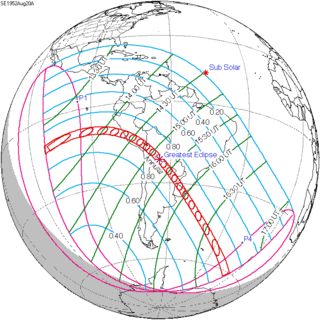Solar eclipse of February 14, 1953
| Solar eclipse of February 14, 1953 | |
|---|---|
 Map | |
| Type of eclipse | |
| Nature | Partial |
| Gamma | 1.1331 |
| Magnitude | 0.7596 |
| Maximum eclipse | |
| Coordinates | 61°54′N 104°54′E / 61.9°N 104.9°E |
| Times (UTC) | |
| Greatest eclipse | 0:59:30 |
| References | |
| Saros | 149 (17 of 71) |
| Catalog # (SE5000) | 9404 |
A partial solar eclipse occurred on February 14, 1953. A solar eclipse occurs when the Moon passes between Earth and the Sun, thereby totally or partly obscuring the image of the Sun for a viewer on Earth. A partial solar eclipse occurs in the polar regions of the Earth when the center of the Moon's shadow misses the Earth.
Related eclipses
Solar eclipses of 1950-1953
Each member in a semester series of solar eclipses repeats approximately every 177 days and 4 hours (a semester) at alternating nodes of the Moon's orbit.
| Ascending node | Descending node | |||||
|---|---|---|---|---|---|---|
| Saros | Map | Saros | Map | |||
| 119 |  March 18, 1950 Annular |
124 |  September 12, 1950 Total | |||
| 129 |  March 7, 1951 Annular |
134 |  September 1, 1951 Annular | |||
| 139 |  February 25, 1952 Total |
144 |  August 20, 1952 Annular | |||
| 149 |  February 14, 1953 Partial |
154 |  August 9, 1953 Partial | |||
| Solar eclipse of July 11, 1953 belongs to the next lunar year set | ||||||
References
External links
| Wikimedia Commons has media related to Solar eclipse of 1953 February 14. |
This article is issued from Wikipedia - version of the 1/15/2016. The text is available under the Creative Commons Attribution/Share Alike but additional terms may apply for the media files.
